Fabrication of Celecoxib PVP Microparticles Stabilized by Gelucire 48/16 via Electrospraying for Enhanced Anti-Inflammatory Action
Abstract
1. Introduction
2. Results
2.1. Solubility Study of CXB in Gelurice® 48/16
2.2. Characterization of GLR-PVP MPs Loaded with CXB
2.2.1. Particle Size, PDI, Zeta Potential, Drug Loading (DL), and Surface Morphology
2.2.2. In Vitro Release Pattern
2.2.3. FTIR Spectroscopy
2.2.4. X-ray Diffractometry (XRD)
2.3. In Vivo Anti-Inflammatory Study
2.3.1. Edema Weight
2.3.2. Histological Investigations
2.3.3. Immunohistochemical Investigations
2.3.4. Pro-Inflammatory and Oxidative Stress Indicators
2.3.5. The mRNA Expression of IL-1β as Well as IL-6
3. Discussion
4. Material and Methods
4.1. Chemicals and Material
4.2. Solubility Study of CXB in Gelurice® 48/16
4.3. Electrospraying Process
4.4. Characterization of GLR-PVP MPs Loaded with CXB
4.4.1. Particle Diameter, Polydispersity Index (PDI), and Surface Charge
4.4.2. Drug Loading (DL)
4.4.3. In Vitro Release
4.4.4. Scanning Electron Microscopy (SEM)
4.4.5. Spectroscopic Analysis by FTIR
4.4.6. XRD
4.5. In Vivo Anti-Inflammatory Study
4.5.1. Rats
4.5.2. Inflammation-Induced by Carrageenan
4.5.3. Protocol of the Experiment
4.5.4. Histological Investigations
4.5.5. Immunohistochemical Studies
4.5.6. ELISA and Colorimetric Assay
4.5.7. qRT-PCR
4.6. Statistics
5. Conclusions
Supplementary Materials
Author Contributions
Funding
Institutional Review Board Statement
Informed Consent Statement
Data Availability Statement
Acknowledgments
Conflicts of Interest
References
- Gong, L.; Thorn, C.F.; Bertagnolli, M.M.; Grosser, T.; Altman, R.B.; Klein, T.E. Celecoxib Pathways: Pharmacokinetics and Pharmacodynamics. Pharmacogenet. Genom. 2012, 22, 310–318. [Google Scholar]
- Alexanian, A.; Sorokin, A. Cyclooxygenase 2: Protein-Protein Interactions and Posttranslational Modifications. Physiol. Genom. 2017, 49, 667–681. [Google Scholar]
- Jo, K.; Cho, J.M.; Lee, H.; Kim, E.K.; Kim, H.C.; Kim, H.; Lee, J. Enhancement of Aqueous Solubility and Dissolution of Celecoxib through Phosphatidylcholine-Based Dispersion Systems Solidified with Adsorbent Carriers. Pharmaceutics 2018, 11, 1. [Google Scholar] [PubMed]
- Sychrová, A.; Koláriková, I.; Žemlička, M.; Šmejkal, K. Natural Compounds with Dual Antimicrobial and Anti-Inflammatory Effects. Phytochem. Rev. 2020, 19, 1471–1502. [Google Scholar] [CrossRef]
- Kaneko, N.; Kurata, M.; Yamamoto, T.; Morikawa, S.; Masumoto, J. The Role of Interleukin-1 in General Pathology. Inflamm. Regen. 2019, 39, 12. [Google Scholar] [CrossRef] [PubMed]
- Rea, I.M.; Gibson, D.S.; McGilligan, V.; McNerlan, S.E.; Alexander, H.D.; Ross, O.A. Age and Age-Related Diseases: Role of Inflammation Triggers and Cytokines. Front. Immunol. 2018, 9, 586. [Google Scholar] [CrossRef] [PubMed]
- Bertoni, S.; Albertini, B.; Passerini, N. Different BCS Class II Drug-Gelucire Solid Dispersions Prepared by Spray Congealing: Evaluation of Solid State Properties and in Vitro Performances. Pharmaceutics 2020, 12, 548. [Google Scholar]
- Dolenc, A.; Kristl, J.; Baumgartner, S.; Planinšek, O. Advantages of Celecoxib Nanosuspension Formulation and Transformation into Tablets. Int. J. Pharm. 2009, 376, 204–212. [Google Scholar] [CrossRef]
- Shinde, U.K.; Suryawanshi, D.G.; Amin, P.D. Development of Gelucire® 48/16 and TPGS Mixed Micelles and Its Pellet Formulation by Extrusion Spheronization Technique for Dissolution Rate Enhancement of Curcumin. AAPS PharmSciTech 2021, 22, 182. [Google Scholar]
- Febriyenti, F.; Rahmi, S.; Halim, A. Study of Gliclazide Solid Dispersion Systems Using PVP K-30 and PEG 6000 by Solvent Method. J. Pharm. Bioallied Sci. 2019, 11, 262–267. [Google Scholar] [CrossRef]
- Pandya, V.M.; Patel, D.J.; Patel, J.K.; Patel, R.P. Formulation, Characterization, and Optimization of Fast-Dissolve Tablets Containing Celecoxib Solid Dispersion. Dissolut. Technol. 2009, 16, 22–27. [Google Scholar] [CrossRef]
- Morais, A.Í.S.; Vieira, E.G.; Afewerki, S.; Sousa, R.B.; Honorio, L.M.C.; Cambrussi, A.N.C.O.; Santos, J.A.; Bezerra, R.D.S.; Furtini, J.A.O.; Silva-Filho, E.C.; et al. Fabrication of Polymeric Microparticles by Electrospray: The Impact of Experimental Parameters. J. Funct. Biomater. 2020, 11, 4. [Google Scholar]
- Panigrahi, K.C.; Patra, C.N.; Jena, G.K.; Ghose, D.; Jena, J.; Panda, S.K.; Sahu, M. Gelucire: A Versatile Polymer for Modified Release Drug Delivery System. Futur. J. Pharm. Sci. 2018, 4, 102–108. [Google Scholar] [CrossRef]
- Sistla, R.; Shastri, N.R. Modulating Drug Release Profiles by Lipid Semi Solid Matrix Formulations for BCS Class II Drug—An In Vitro and an In Vivo Study. Drug Deliv. 2014, 22, 418–426. [Google Scholar]
- Almukainzi, M.; El-Masry, T.A.; Negm, W.A.; Elekhnawy, E.; Saleh, A.; Sayed, A.E.; Ahmed, H.M.; Abdelkader, D.H. Co-Delivery of Gentiopicroside and Thymoquinone Using Electrospun m-PEG/PVP Nanofibers: In-Vitro and In Vivo Studies for Antibacterial Wound Dressing in Diabetic Rats. Int. J. Pharm. 2022, 625, 122106. [Google Scholar] [CrossRef]
- Sriyanti, I.; Sriyanti, I.; Edikresnha, D.; Munir, M.M.; Khairurrijal, K. Electrosprayed Polyvinylpyrrolidone (PVP) Submicron Particles Loaded by Green Tea Extracts. In Proceedings of the 5th International Conference on Advanced Materials Sciences and Technology (ICAMST 2017), Makassar, Indonesia, 19–20 September 2017; Volume 367. [Google Scholar]
- Luo, Y.; Hong, Y.; Shen, L.; Wu, F.; Lin, X. Multifunctional Role of Polyvinylpyrrolidone in Pharmaceutical Formulations. AAPS PharmSciTech 2021, 22, 34. [Google Scholar] [CrossRef]
- Bergström, C.A.S.; Larsson, P. Computational Prediction of Drug Solubility in Water-Based Systems: Qualitative and Quantitative Approaches Used in the Current Drug Discovery and Development Setting. Int. J. Pharm. 2018, 540, 185–193. [Google Scholar]
- Seok, S.H.; Lee, S.-A.; Park, E.-S. Formulation of a Microemulsion-Based Hydrogel Containing Celecoxib. J. Drug Deliv. Sci. Technol. 2018, 43, 409–414. [Google Scholar]
- Mukesh, S.; Joshi, P.; Bansal, A.K.; Kashyap, M.C.; Mandal, S.K.; Sathe, V.; Sangamwar, A.T. Amorphous Salts Solid Dispersions of Celecoxib: Enhanced Biopharmaceutical Performance and Physical Stability. Mol. Pharm. 2021, 18, 2334–2348. [Google Scholar]
- Jansook, P.; Kulsirachote, P.; Loftsson, T. Cyclodextrin Solubilization of Celecoxib: Solid and Solution State Characterization. J. Incl. Phenom. Macrocycl. Chem. 2018, 90, 75–88. [Google Scholar]
- Jain, S.K.; Gupta, Y.; Jain, A.; Bhola, M. Multivesicular Liposomes Bearing Celecoxib-β-Cyclodextrin Complex for Transdermal Delivery. Drug Deliv. 2007, 14, 327–335. [Google Scholar] [PubMed]
- Pöstges, F.; Kayser, K.; Stoyanov, E.; Wagner, K.G. Boost of Solubility and Supersaturation of Celecoxib via Synergistic Interactions of Methacrylic Acid-Ethyl Acrylate Copolymer (1: 1) and Hydroxypropyl Cellulose in Ternary Amorphous Solid Dispersions. Int. J. Pharm. X 2022, 4, 100115. [Google Scholar] [PubMed]
- Ghanavati, R.; Taheri, A.; Homayouni, A. Anomalous Dissolution Behavior of Celecoxib in PVP/Isomalt Solid Dispersions Prepared Using Spray Drier. Mater. Sci. Eng. C 2017, 72, 501–511. [Google Scholar] [CrossRef]
- Nazem, N.M.; Shokri, J.; Nourani, N.; Zangi, A.R.; Lam, M.; Nokhodchi, A.; Javadzadeh, Y. Combining Liquisolid and Co-Grinding Techniques to Enhance the Dissolution Rate of Celecoxib. J. Pharm. Innov. 2022, 1–10. [Google Scholar] [CrossRef]
- Zingale, E.; Rizzo, S.; Bonaccorso, A.; Consoli, V.; Vanella, L.; Musumeci, T.; Spadaro, A.; Pignatello, R. Optimization of Lipid Nanoparticles by Response Surface Methodology to Improve the Ocular Delivery of Diosmin: Characterization and In-Vitro Anti-Inflammatory Assessment. Pharmaceutics 2022, 14, 1961. [Google Scholar] [CrossRef]
- Patnaik, S.; Kurdekar, A.D.; Chunduri, L.A.A.; Prathibha, C.; Venkataramaniah, K. Naproxen-Gelucire Nanoformulations for Improved Solubility and Dissolution Rate of Poorly Water-Soluble Drug Naproxen. J. Drug Des. Med. Chem. 2017, 3, 77–85. [Google Scholar] [CrossRef]
- Shin, D.J.; Chae, B.R.; Goo, Y.T.; Yoon, H.Y.; Kim, C.H.; Sohn, S.I.; Oh, D.; Lee, A.; Song, S.H.; Choi, Y.W. Improved Dissolution and Oral Bioavailability of Valsartan Using a Solidified Supersaturable Self-Microemulsifying Drug Delivery System Containing Gelucire® 44/14. Pharmaceutics 2019, 11, 58. [Google Scholar] [PubMed]
- Radke, R.; Jain, N.K. Enhancement of Solubility and Bioavailability of BCS Class-II Ambrisentan: In Vitro, In Vivo And Ex Vivo Analysis. Int. J. App. Pharm. 2022, 14, 67–74. [Google Scholar]
- Abdelkader, D.H.; Abosalha, A.K.; Khattab, M.A.; Aldosari, B.N.; Almurshedi, A.S. A Novel Sustained Anti-Inflammatory Effect of Atorvastatin—Calcium PLGA Nanoparticles: In Vitro Optimization and In Vivo Evaluation. Pharmaceutics 2021, 13, 1658. [Google Scholar] [CrossRef]
- Salgado, C.; Guenee, L.; Černý, R.; Allemann, E.; Jordan, O. Nano Wet Milled Celecoxib Extended Release Microparticles for Local Management of Chronic Inflammation. Int. J. Pharm. 2020, 589, 119783. [Google Scholar] [CrossRef]
- Ochiuz, L.; Grigoras, C.; Popa, M.; Stoleriu, I.; Munteanu, C.; Timofte, D.; Profire, L.; Grigoras, A.G. Alendronate-Loaded Modified Drug Delivery Lipid Particles Intended for Improved Oral and Topical Administration. Molecules 2016, 21, 858. [Google Scholar] [CrossRef]
- Chen, L.; Deng, H.; Cui, H.; Fang, J.; Zuo, Z.; Deng, J.; Li, Y.; Wang, X.; Zhao, L. Inflammatory Responses and Inflammation-Associated Diseases in Organs. Oncotarget 2018, 9, 7204. [Google Scholar] [CrossRef]
- Patil, K.R.; Mahajan, U.B.; Unger, B.S.; Goyal, S.N.; Belemkar, S.; Surana, S.J.; Ojha, S.; Patil, C.R. Animal Models of Inflammation for Screening of Anti-Inflammatory Drugs: Implications for the Discovery and Development of Phytopharmaceuticals. Int. J. Mol. Sci. 2019, 20, 4367. [Google Scholar] [CrossRef]
- Zamorano, M.; Castillo, R.L.; Beltran, J.F.; Herrera, L.; Farias, J.A.; Antileo, C.; Aguilar-Gallardo, C.; Pessoa, A.; Calle, Y.; Farias, J.G. Tackling Ischemic Reperfusion Injury with the Aid of Stem Cells and Tissue Engineering. Front. Physiol. 2021, 12, 705256. [Google Scholar]
- Wiig, H. Pathophysiology of Tissue Fluid Accumulation in Inflammation. J. Physiol. 2011, 589, 2945–2953. [Google Scholar] [CrossRef]
- Apostolova, E.; Lukova, P.; Baldzhieva, A.; Katsarov, P.; Nikolova, M.; Iliev, I.; Peychev, L.; Trica, B.; Oancea, F.; Delattre, C. Immunomodulatory and Anti-Inflammatory Effects of Fucoidan: A Review. Polymers 2020, 12, 2338. [Google Scholar] [CrossRef]
- Cooper, D.L.; Harirforoosh, S. Effect of Formulation Variables on Preparation of Celecoxib Loaded Polylactide-Co-Glycolide Nanoparticles. PLoS ONE 2014, 9, e113558. [Google Scholar] [CrossRef]
- Bazan, L.; Bendas, E.R.; El Gazayerly, O.N.; Badawy, S.S. Comparative Pharmaceutical Study on Colon Targeted Micro-Particles of Celecoxib: In-Vitro–in-Vivo Evaluation. Drug Deliv. 2016, 23, 3339–3349. [Google Scholar]
- Alaaeldin, E.; Abou-Taleb, H.A.; Mohamad, S.A.; Elrehany, M.; Gaber, S.S.; Mansour, H.F. Topical Nano-Vesicular Spanlastics of Celecoxib: Enhanced Anti-Inflammatory Effect and down-Regulation of TNF-α, NF-KB and COX-2 in Complete Freund’s Adjuvant-Induced Arthritis Model in Rats. Int. J. Nanomed. 2021, 16, 133. [Google Scholar]
- Guay, J.; Bateman, K.; Gordon, R.; Mancini, J.; Riendeau, D. Carrageenan-Induced Paw Edema in Rat Elicits a Predominant Prostaglandin E2 (PGE2) Response in the Central Nervous System Associated with the Induction of Microsomal PGE2 Synthase-1. J. Biol. Chem. 2004, 279, 24866–24872. [Google Scholar]
- El-Medany, A.; Mahgoub, A.; Mustafa, A.; Arafa, M.; Morsi, M. The Effects of Selective Cyclooxygenase-2 Inhibitors, Celecoxib and Rofecoxib, on Experimental Colitis Induced by Acetic Acid in Rats. Eur. J. Pharmacol. 2005, 507, 291–299. [Google Scholar] [PubMed]
- Zhang, J.; Huang, C.; Chen, J.; Xu, R. Equilibrium Solubility Determination and Modeling of Fenbendazole in Cosolvent Mixtures at (283.15–328.15) K. J. Chem. Eng. Data 2019, 64, 4095–4102. [Google Scholar] [CrossRef]
- Attimarad, M.; Narayanswamy, V.K.; Aldhubaib, B.E.; SreeHarsha, N.; Nair, A.B. Development of UV Spectrophotometry Methods for Concurrent Quantification of Amlodipine and Celecoxib by Manipulation of Ratio Spectra in Pure and Pharmaceutical Formulation. PLoS ONE 2019, 14, e0222526. [Google Scholar] [CrossRef]
- Abdelkader, D.H.; Osman, M.A.; El-Gizawy, S.A.; Hawthorne, S.J.; Faheem, A.M.; McCarron, P.A. Effect of Poly(Ethylene Glycol) on Insulin Stability and Cutaneous Cell Proliferation in Vitro Following Cytoplasmic Delivery of Insulin-Loaded Nanoparticulate Carriers—A Potential Topical Wound Management Approach. Eur. J. Pharm. Sci. 2018, 114, 372–384. [Google Scholar] [CrossRef]
- Almukainzi, M.; El-masry, T.A.; Negm, W.A.; Elekhnawy, E.; Saleh, A.; Sayed, A.E.; Khattab, M.A.; Abdelkader, D.H. Gentiopicroside PLGA Nanospheres: Fabrication, In Vitro Characterization, Antimicrobial Action, and In Vivo Effect for Enhancing Wound Healing in Diabetic Rats. Int. J. Nanomed. 2022, 17, 1203–1225. [Google Scholar] [CrossRef]
- Abdelkader, D.H.; Negm, W.A.; Elekhnawy, E.; Eliwa, D.; Aldosari, B.N.; Almurshedi, A.S. Zinc Oxide Nanoparticles as Potential Delivery Carrier: Green Synthesis by Aspergillus Niger Endophytic Fungus, Characterization, and In Vitro/In Vivo Antibacterial Activity. Pharmaceuticals 2022, 15, 1057. [Google Scholar] [CrossRef] [PubMed]
- Abdelkader, D.H.; Elekhnawy, E.; Negm, W.A.; El-Masry, T.A.; Almukainzi, M.; Zayed, A.; Ulber, R. Insight into Fucoidan-Based PEGylated PLGA Nanoparticles Encapsulating Methyl Anthranilic Acid: In Vitro Evaluation and In Vivo Anti-Inflammatory Study. Mar. Drugs 2022, 20, 694. [Google Scholar] [CrossRef]
- Alqahtani, M.J.; Elekhnawy, E.; Negm, W.A.; Mahgoub, S.; Hussein, I.A. Encephalartos Villosus Lem. Displays a Strong In Vivo and In Vitro Antifungal Potential against Candida glabrata Clinical Isolates. J. Fungi 2022, 8, 521. [Google Scholar]
- Negm, W.A.; El-Kadem, A.H.; Elekhnawy, E.; Attallah, N.G.M.; Al-Hamoud, G.A.; El-Masry, T.A.; Zayed, A. Wound-Healing Potential of Rhoifolin-Rich Fraction Isolated from Sanguisorba officinalis Roots Supported by Enhancing Re-Epithelization, Angiogenesis, Anti-Inflammatory, and Antimicrobial Effects. Pharmaceuticals 2022, 15, 178. [Google Scholar]
- Wang, K.; Yuan, C.-P.; Wang, W.; Yang, Z.-Q.; Cui, W.; Mu, L.-Z.; Yue, Z.-P.; Yin, X.-L.; Hu, Z.-M.; Liu, J.-X. Expression of Interleukin 6 in Brain and Colon of Rats with TNBS-Induced Colitis. World J. Gastroenterol. 2010, 16, 2252–2259. [Google Scholar]
- Peinnequin, A.; Mouret, C.; Birot, O.; Alonso, A.; Mathieu, J.; Clarençon, D.; Agay, D.; Chancerelle, Y.; Multon, E. Rat Pro-Inflammatory Cytokine and Cytokine Related MRNA Quantification by Real-Time Polymerase Chain Reaction Using SYBR Green. BMC Immunol. 2004, 5, 3. [Google Scholar]



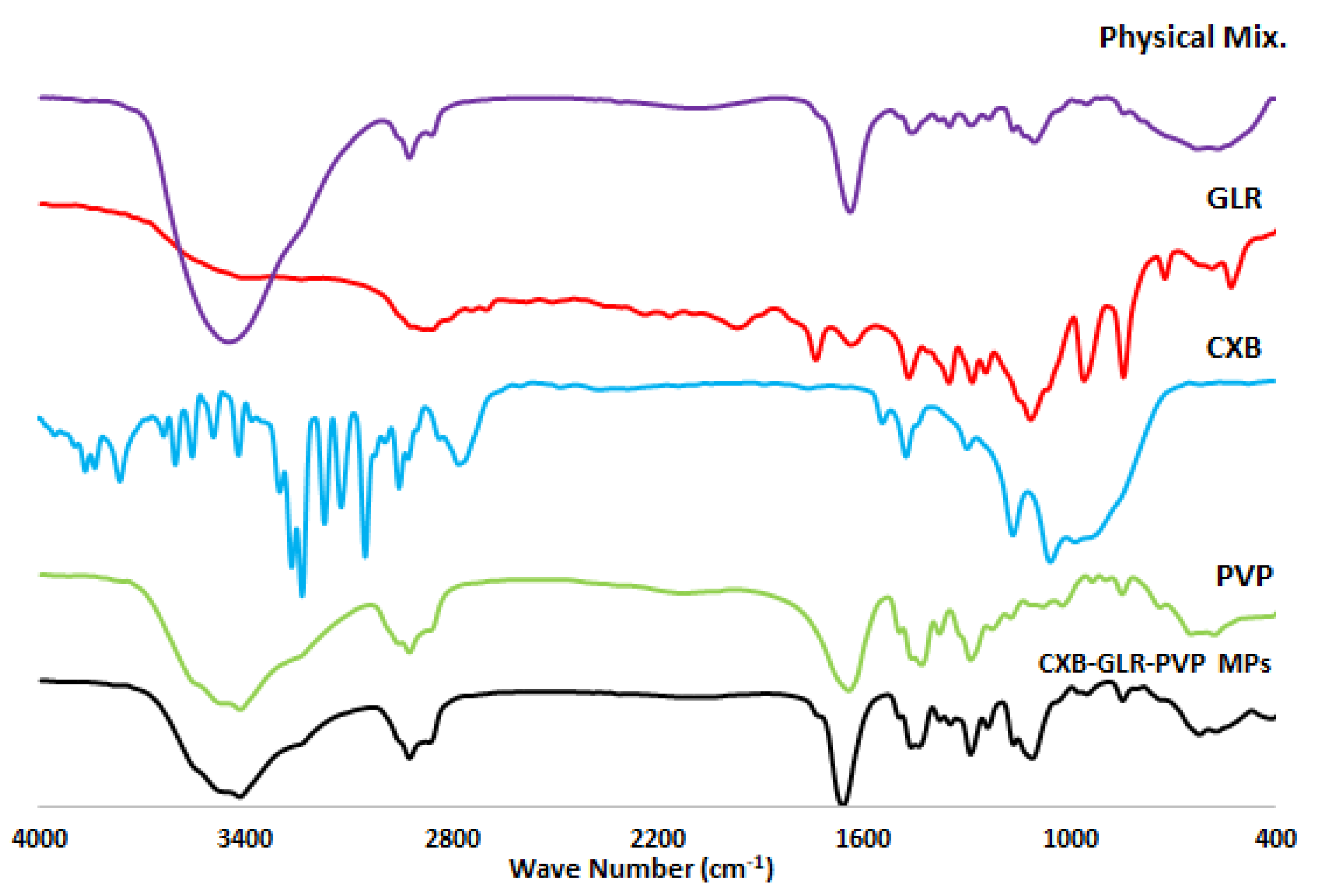
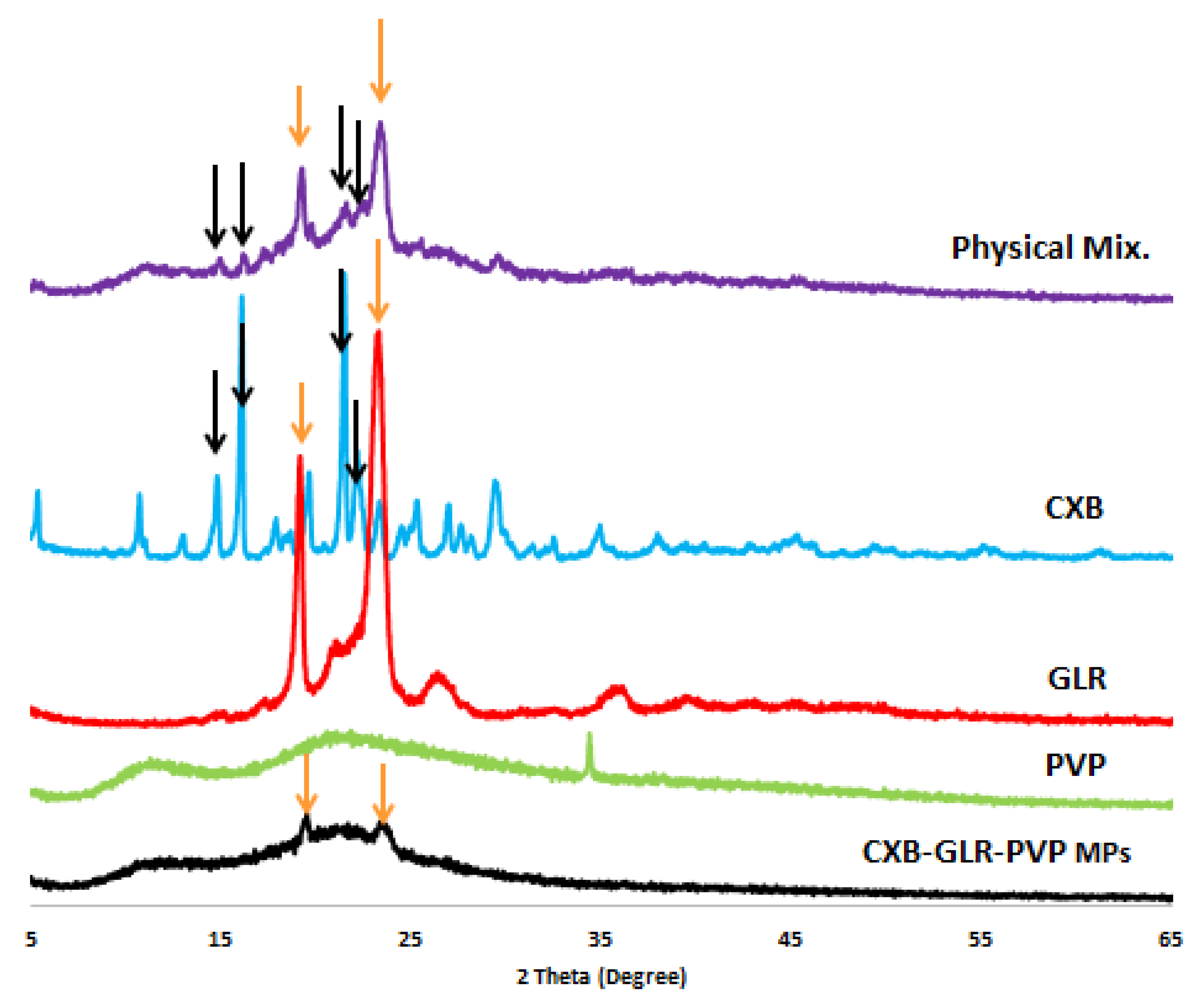

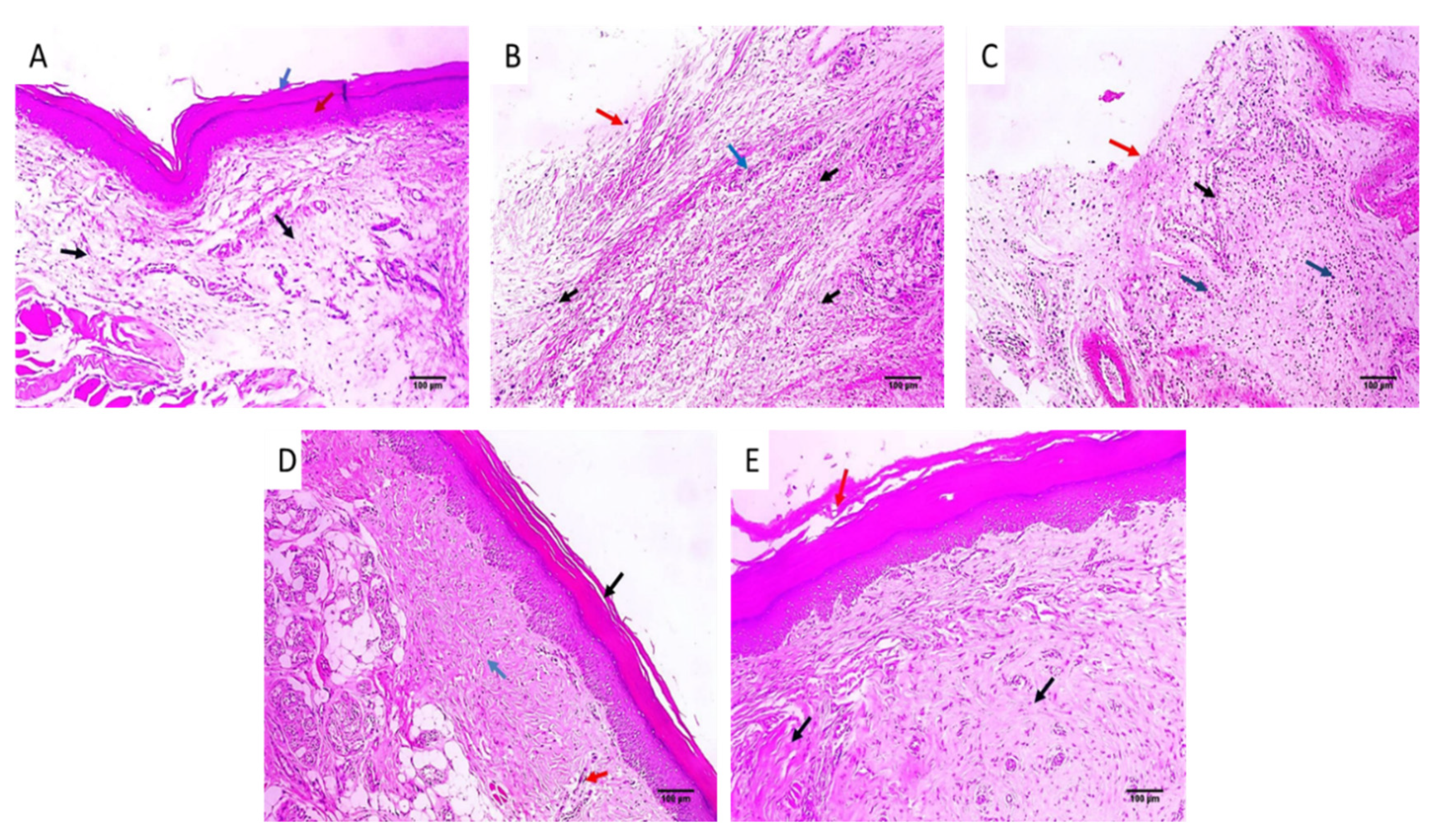

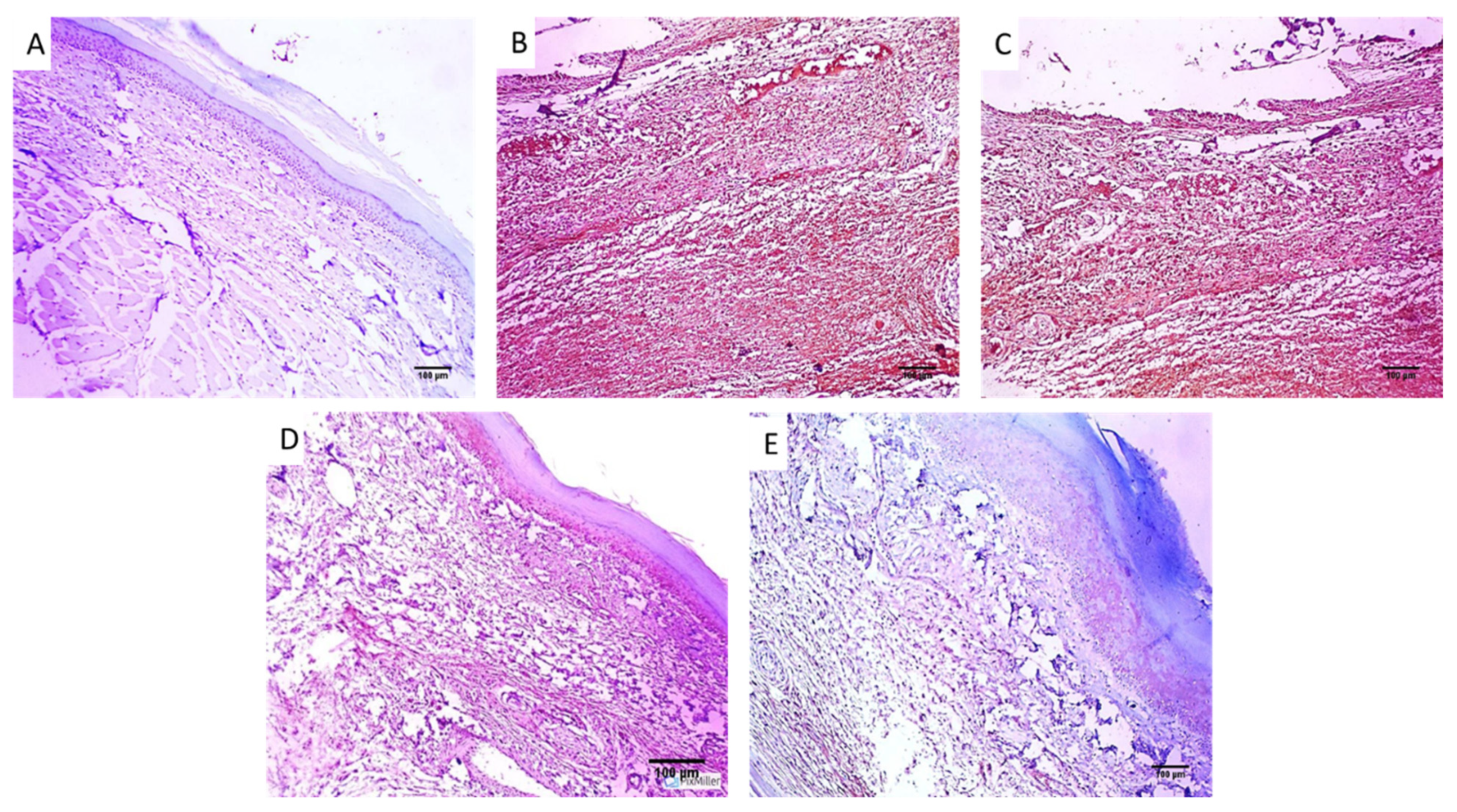
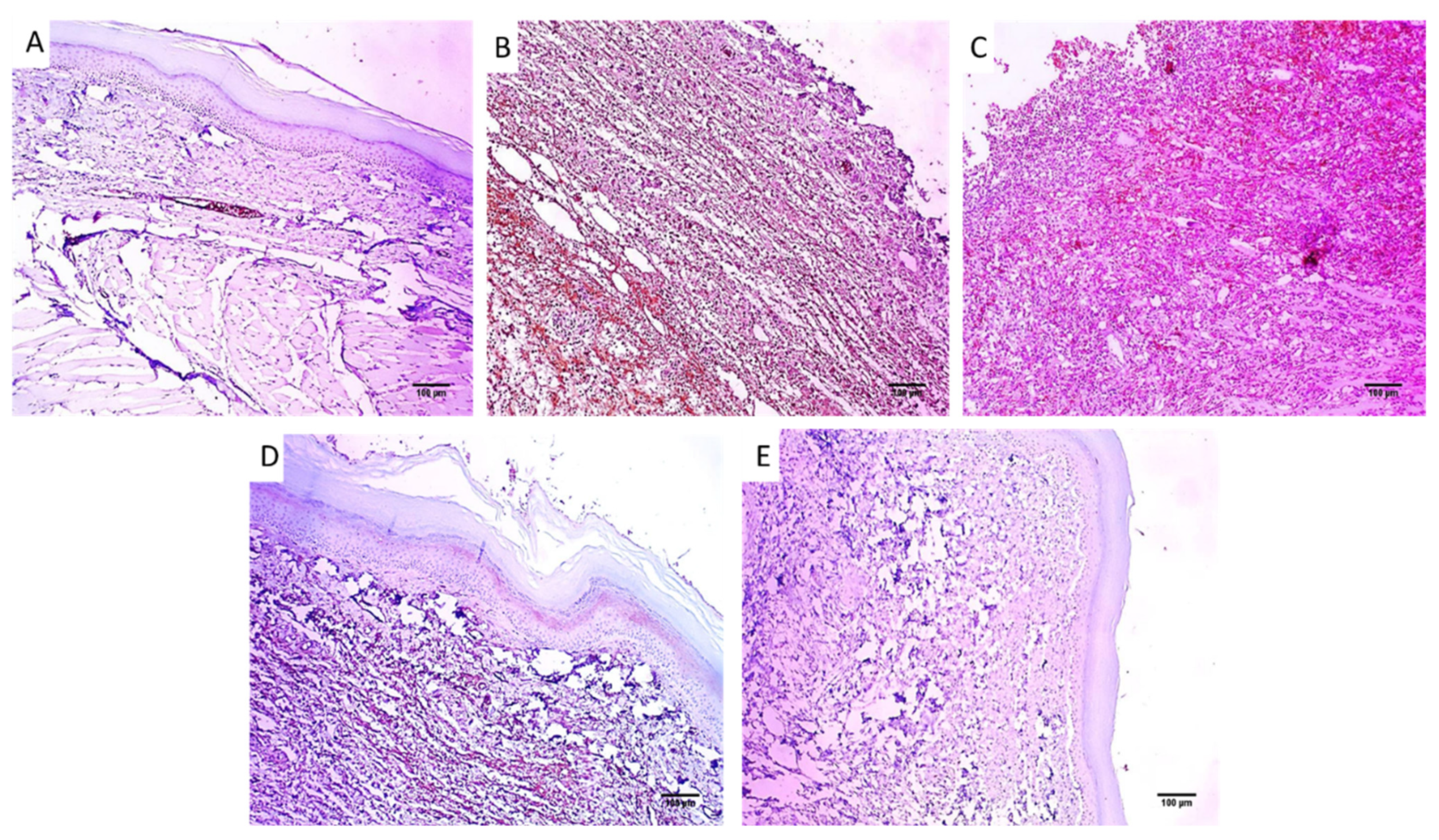



| Gelurice® 48/16 Conc. (% w/v) | Solubility of CXB (mg/mL) | ΔGotr (kJ/moL) |
|---|---|---|
| 0 | 0.007 ± 0.001 | 0.00 |
| 5 | 0.752 ± 0.025 | −9.52 |
| 10 | 1.256 ± 0.029 | −11.26 |
| 15 | 2.136 ± 0.036 | −12.45 |
| 20 | 4.359 ± 0.031 | −14.36 |
| 25 | 7.236 ± 0.039 | −15.69 |
| 30 | 7.934 ± 0.048 | −15.89 |
| Assignment | Approximate Frequency (cm−1) | |
|---|---|---|
| CXB [11,19] | NH | 3344, 3235 |
| S=O | 1348, 1164 | |
| NH | 1621 | |
| aromatic CH | 761 | |
| PVP K30 [10] | O-H | 3416 |
| -CH2 | 2953, 2922 | |
| C=O | 1642 | |
| C-H | 1378 | |
| C-N | 1287 | |
| δ CH2 | 846 | |
| δ N-C=O | 577 | |
| Gelurice® 48/16 [9] | sulfone | 1112 |
| C=O | 1738, 1636 | |
| =C-H & =CH2 | 956, 842 | |
| O-H | 721 | |
| C-N | 1243 | |
| O-H | 2858 |
Disclaimer/Publisher’s Note: The statements, opinions and data contained in all publications are solely those of the individual author(s) and contributor(s) and not of MDPI and/or the editor(s). MDPI and/or the editor(s) disclaim responsibility for any injury to people or property resulting from any ideas, methods, instructions or products referred to in the content. |
© 2023 by the authors. Licensee MDPI, Basel, Switzerland. This article is an open access article distributed under the terms and conditions of the Creative Commons Attribution (CC BY) license (https://creativecommons.org/licenses/by/4.0/).
Share and Cite
Alshawwa, S.Z.; El-Masry, T.A.; Elekhnawy, E.; Alotaibi, H.F.; Sallam, A.-S.; Abdelkader, D.H. Fabrication of Celecoxib PVP Microparticles Stabilized by Gelucire 48/16 via Electrospraying for Enhanced Anti-Inflammatory Action. Pharmaceuticals 2023, 16, 258. https://doi.org/10.3390/ph16020258
Alshawwa SZ, El-Masry TA, Elekhnawy E, Alotaibi HF, Sallam A-S, Abdelkader DH. Fabrication of Celecoxib PVP Microparticles Stabilized by Gelucire 48/16 via Electrospraying for Enhanced Anti-Inflammatory Action. Pharmaceuticals. 2023; 16(2):258. https://doi.org/10.3390/ph16020258
Chicago/Turabian StyleAlshawwa, Samar Zuhair, Thanaa A. El-Masry, Engy Elekhnawy, Hadil Faris Alotaibi, Al-Sayed Sallam, and Dalia H. Abdelkader. 2023. "Fabrication of Celecoxib PVP Microparticles Stabilized by Gelucire 48/16 via Electrospraying for Enhanced Anti-Inflammatory Action" Pharmaceuticals 16, no. 2: 258. https://doi.org/10.3390/ph16020258
APA StyleAlshawwa, S. Z., El-Masry, T. A., Elekhnawy, E., Alotaibi, H. F., Sallam, A.-S., & Abdelkader, D. H. (2023). Fabrication of Celecoxib PVP Microparticles Stabilized by Gelucire 48/16 via Electrospraying for Enhanced Anti-Inflammatory Action. Pharmaceuticals, 16(2), 258. https://doi.org/10.3390/ph16020258








